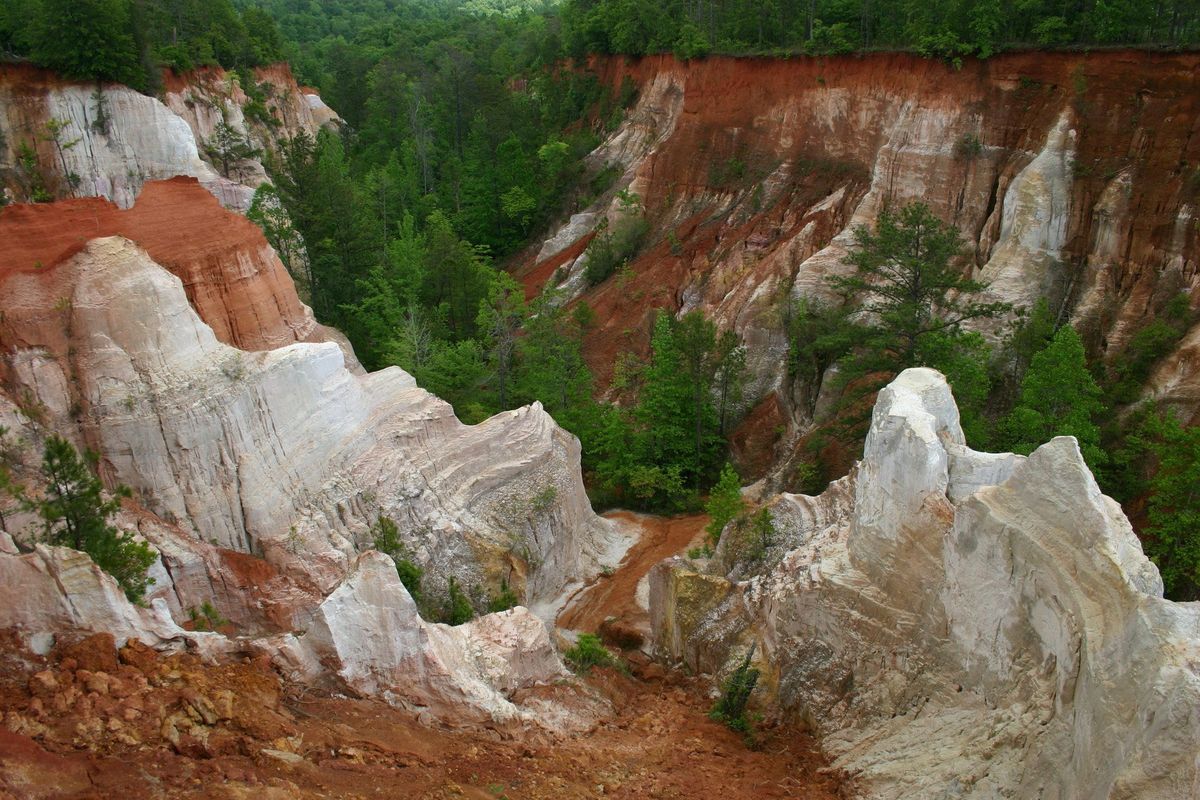Mysteries Behind Georgia’s Providence Canyon

Have you ever wondered why Providence Canyon in Georgia is called the "Little Grand Canyon"? This stunning natural wonder, located in the southwestern part of the state, offers breathtaking views and a unique landscape that rivals its famous counterpart out west. Formed by poor farming practices in the 1800s, the canyon's colorful soil layers create a striking visual effect. Visitors can hike, camp, and even picnic while exploring the area's rich history and natural beauty. Whether you're an avid hiker or just looking for a scenic spot to relax, Providence Canyon has something for everyone. Ready to learn more about this hidden gem?
The Enigmatic Beauty of Providence Canyon
Providence Canyon, often called "Georgia's Little Grand Canyon," is a hidden gem. Its vibrant colors and unique formations make it a must-see. Let's uncover some of the mysteries behind this natural wonder.
How Did Providence Canyon Form?
The formation of Providence Canyon is a tale of human impact and natural processes. Unlike the Grand Canyon, which was carved by the Colorado River, Providence Canyon's creation is more recent and human-induced.
Erosion from Poor Farming Practices: In the 1800s, settlers used poor farming techniques, leading to severe soil erosion. This erosion carved out the deep gullies we see today.
Soft Soil Composition: The canyon's soil is primarily composed of soft, sandy sediments. These sediments erode easily, contributing to the canyon's rapid formation.
Rainwater Runoff: Heavy rainwater runoff further eroded the soil, deepening and widening the gullies over time.
The Vibrant Colors of Providence Canyon
One of the most striking features of Providence Canyon is its array of colors. The canyon walls display a stunning palette that changes with the light and seasons.
Iron Oxide Deposits: The red, orange, and pink hues come from iron oxide deposits in the soil. These minerals oxidize, creating the vibrant colors.
Kaolin Clay: White and light-colored layers are due to kaolin clay, a type of fine, white clay used in porcelain and paper production.
Organic Material: Darker shades in the canyon walls are from organic material and plant roots mixed with the soil.
Unique Flora and Fauna
Providence Canyon is not just about stunning landscapes. It also hosts unique plant and animal species, some of which are rare or endangered.
Plumleaf Azalea: This rare plant blooms in late summer, adding splashes of red and orange to the canyon's palette.
Gopher Tortoise: An endangered species, the gopher tortoise, finds refuge in the sandy soils of the canyon.
Bird Species: The canyon is a haven for birdwatchers, with species like the red-tailed hawk and the eastern bluebird frequently spotted.
Exploring Providence Canyon
Visiting Providence Canyon offers a range of activities for nature lovers and adventure seekers. Whether you're hiking, camping, or simply taking in the views, there's something for everyone.
Hiking Trails: Several trails wind through the canyon, offering different levels of difficulty and stunning views.
Camping Sites: For those who want to immerse themselves in nature, camping sites are available within the park.
Photography Spots: The canyon's unique formations and colors make it a photographer's paradise. Early morning and late afternoon light provide the best conditions for capturing its beauty.
The Cultural Significance of Providence Canyon
Providence Canyon holds cultural and historical importance, reflecting the region's past and the impact of human activity on the environment.
Historical Farming Practices: The canyon serves as a reminder of the consequences of poor land management and the importance of sustainable farming practices.
Local Legends: Stories and legends about the canyon add to its mystique, with tales of hidden treasures and ghostly apparitions.
Educational Programs: The park offers educational programs and guided tours, providing insights into the canyon's history, geology, and ecology.
Protecting Providence Canyon for Future Generations
Preserving Providence Canyon is crucial to maintaining its beauty and ecological significance. Efforts are ongoing to protect this natural wonder and educate the public about its importance.
Conservation Efforts: Various conservation programs aim to prevent further erosion and protect the unique flora and fauna of the canyon.
Public Awareness: Raising awareness about the canyon's history and ecological importance helps garner support for its preservation.
Sustainable Tourism: Promoting sustainable tourism practices ensures that visitors can enjoy the canyon without causing harm to its delicate environment.
The Beauty of Providence Canyon
Providence Canyon, often called Georgia's "Little Grand Canyon," offers a unique blend of natural beauty and historical intrigue. Its striking colors and deep gullies make it a must-visit for nature lovers and history buffs alike. The canyon's formation, driven by poor farming practices in the 1800s, serves as a powerful reminder of the impact humans can have on the environment.
Hiking trails provide stunning views and opportunities for adventure. Whether you're exploring the canyon floor or admiring the scenery from above, there's something for everyone. Don't forget to bring your camera; the vibrant hues of the soil create perfect photo opportunities.
Visiting Providence Canyon is more than just a trip; it's an experience that combines education, recreation, and awe-inspiring landscapes. Make sure to add this hidden gem to your travel list. You won't regret it.

